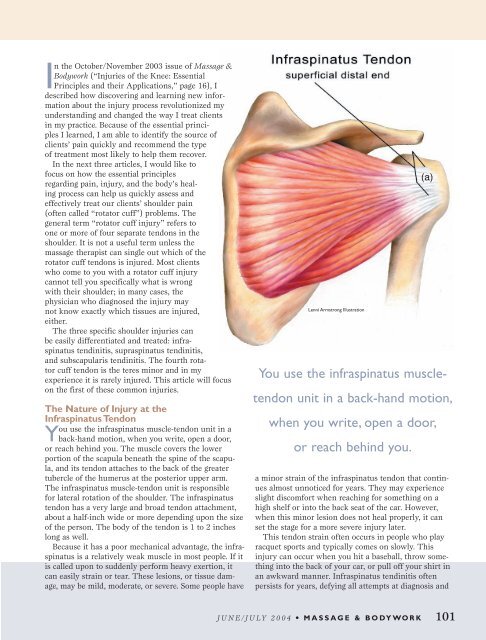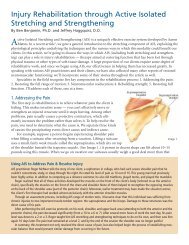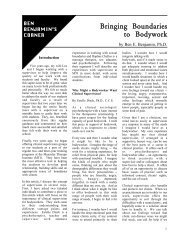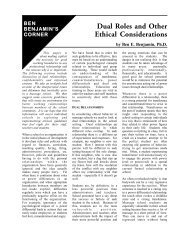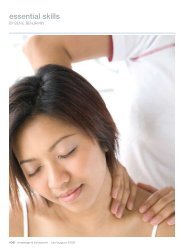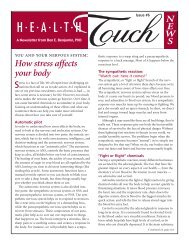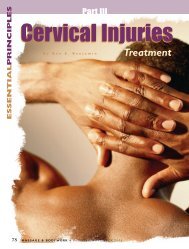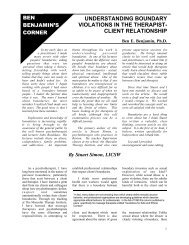Infraspinatus Tendinitis - Ben Benjamin
Infraspinatus Tendinitis - Ben Benjamin
Infraspinatus Tendinitis - Ben Benjamin
- No tags were found...
Create successful ePaper yourself
Turn your PDF publications into a flip-book with our unique Google optimized e-Paper software.
In the October/November 2003 issue of Massage &Bodywork (“Injuries of the Knee: EssentialPrinciples and their Applications,” page 16), Idescribed how discovering and learning new informationabout the injury process revolutionized myunderstanding and changed the way I treat clientsin my practice. Because of the essential principlesI learned, I am able to identify the source ofclients’ pain quickly and recommend the typeof treatment most likely to help them recover.In the next three articles, I would like tofocus on how the essential principlesregarding pain, injury, and the body’s healingprocess can help us quickly assess andeffectively treat our clients’ shoulder pain(often called “rotator cuff”) problems. Thegeneral term “rotator cuff injury” refers toone or more of four separate tendons in theshoulder. It is not a useful term unless themassage therapist can single out which of therotator cuff tendons is injured. Most clientswho come to you with a rotator cuff injurycannot tell you specifically what is wrongwith their shoulder; in many cases, thephysician who diagnosed the injury maynot know exactly which tissues are injured,either.The three specific shoulder injuries canbe easily differentiated and treated: infraspinatustendinitis, supraspinatus tendinitis,and subscapularis tendinitis. The fourth rotatorcuff tendon is the teres minor and in myexperience it is rarely injured. This article will focuson the first of these common injuries.The Nature of Injury at the<strong>Infraspinatus</strong> TendonYou use the infraspinatus muscle-tendon unit in aback-hand motion, when you write, open a door,or reach behind you. The muscle covers the lowerportion of the scapula beneath the spine of the scapula,and its tendon attaches to the back of the greatertubercle of the humerus at the posterior upper arm.The infraspinatus muscle-tendon unit is responsiblefor lateral rotation of the shoulder. The infraspinatustendon has a very large and broad tendon attachment,about a half-inch wide or more depending upon the sizeof the person. The body of the tendon is 1 to 2 incheslong as well.Because it has a poor mechanical advantage, the infraspinatusis a relatively weak muscle in most people. If itis called upon to suddenly perform heavy exertion, itcan easily strain or tear. These lesions, or tissue damage,may be mild, moderate, or severe. Some people haveLenni Armstrong IllustrationYou use the infraspinatus muscletendonunit in a back-hand motion,when you write, open a door,or reach behind you.(a)a minor strain of the infraspinatus tendon that continuesalmost unnoticed for years. They may experienceslight discomfort when reaching for something on ahigh shelf or into the back seat of the car. However,when this minor lesion does not heal properly, it canset the stage for a more severe injury later.This tendon strain often occurs in people who playracquet sports and typically comes on slowly. Thisinjury can occur when you hit a baseball, throw somethinginto the back of your car, or pull off your shirt inan awkward manner. <strong>Infraspinatus</strong> tendinitis oftenpersists for years, defying all attempts at diagnosis andJUNE/JULY 2004 • MASSAGE & BODYWORK 101


